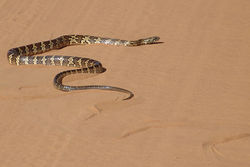Difference between revisions of "Snake Locomotion"
| (12 intermediate revisions by 3 users not shown) | |||
| Line 1: | Line 1: | ||
| − | {{ | + | {{OpenPagesTop}} |
| + | [[Image:Snake_Locomotion-_Sidewinding.jpg|250px|thumb|right|'''Snake locomotion: sidewinding''' Source: Wikimedia Commons; Author: José Reynaldo da Fonseca (2007)]] | ||
| + | ==Introduction== | ||
Since snakes lack limbs locomotion is very different to most other vertebrates. Locomotion is produced by different types of movement based on absence or presence of contact between the animal's body and the medium through which the snake is moving. Most species can use different types of locomotion but some species are specialised and use only one. | Since snakes lack limbs locomotion is very different to most other vertebrates. Locomotion is produced by different types of movement based on absence or presence of contact between the animal's body and the medium through which the snake is moving. Most species can use different types of locomotion but some species are specialised and use only one. | ||
==Lateral undulation== | ==Lateral undulation== | ||
| − | Lateral undulation is the type of locomotion usually associated with snakes i.e. side to side wriggling. At any given time various areas of the snake’s body are pushing simultaneously against a number of fixed points. As the snake moves forward new contact points are made. This is identical for movement across desert, through branches or swimming. | + | Lateral undulation is the type of locomotion usually associated with snakes (i.e. side to side wriggling). At any given time various areas of the snake’s body are pushing simultaneously against a number of fixed points. As the snake moves forward new contact points are made. This is identical for movement across desert, through branches or swimming. |
| − | * | + | * The fastest terrestrial snakes use this method of locomotion. |
| − | + | ==Concertina locomotion== | |
| + | This is common in burrowing snakes and can be seen when a snake crawls through a tube. While the back half of the body acts as an anchor the front half is pushed forward. The back half is then drawn forward. | ||
| − | * | + | * This type of locomotion is common in arboreal and fossorial snakes and requires the most energy. |
| − | * | + | ==Rectilinear crawling== |
| + | The edges of the scales act as anchor points and the muscles then pull the body up to that point. This is often used by large snakes. The motion is similar to that of a caterpillar crawling and involves waves of bilaterally symmetrical muscle contractions. | ||
| + | |||
| + | * This type of locomotion is common in [[Boidae|boas]], [[Pythoninae|pythons]], and stocky [[Viperidae|vipers]]. | ||
| + | |||
| + | ==Sidewinding== | ||
| + | This is similar to concertina locomotion but the angle of movement is at 45 degrees to the direction that the snake is pointing. | ||
| + | |||
| + | * '''For information on snake physical examinations, [[Snake Physical Examination|see here]]'''. | ||
| + | |||
| + | * '''For information on the snake musculoskeletal system, [[Snake Musculoskeletal System|see here]]'''. | ||
| + | |||
| + | |||
| + | {{review}} | ||
| + | |||
| + | {{OpenPages}} | ||
| + | |||
| + | [[Category:Snake_Physiology]] | ||
Latest revision as of 16:37, 18 August 2012
Introduction
Since snakes lack limbs locomotion is very different to most other vertebrates. Locomotion is produced by different types of movement based on absence or presence of contact between the animal's body and the medium through which the snake is moving. Most species can use different types of locomotion but some species are specialised and use only one.
Lateral undulation
Lateral undulation is the type of locomotion usually associated with snakes (i.e. side to side wriggling). At any given time various areas of the snake’s body are pushing simultaneously against a number of fixed points. As the snake moves forward new contact points are made. This is identical for movement across desert, through branches or swimming.
- The fastest terrestrial snakes use this method of locomotion.
Concertina locomotion
This is common in burrowing snakes and can be seen when a snake crawls through a tube. While the back half of the body acts as an anchor the front half is pushed forward. The back half is then drawn forward.
- This type of locomotion is common in arboreal and fossorial snakes and requires the most energy.
Rectilinear crawling
The edges of the scales act as anchor points and the muscles then pull the body up to that point. This is often used by large snakes. The motion is similar to that of a caterpillar crawling and involves waves of bilaterally symmetrical muscle contractions.
Sidewinding
This is similar to concertina locomotion but the angle of movement is at 45 degrees to the direction that the snake is pointing.
- For information on snake physical examinations, see here.
- For information on the snake musculoskeletal system, see here.
| This article has been peer reviewed but is awaiting expert review. If you would like to help with this, please see more information about expert reviewing. |
Error in widget FBRecommend: unable to write file /var/www/wikivet.net/extensions/Widgets/compiled_templates/wrt69375886c52cd5_74190933 Error in widget google+: unable to write file /var/www/wikivet.net/extensions/Widgets/compiled_templates/wrt69375886cbd536_20783026 Error in widget TwitterTweet: unable to write file /var/www/wikivet.net/extensions/Widgets/compiled_templates/wrt69375886d12ff9_55807199
|
| WikiVet® Introduction - Help WikiVet - Report a Problem |
